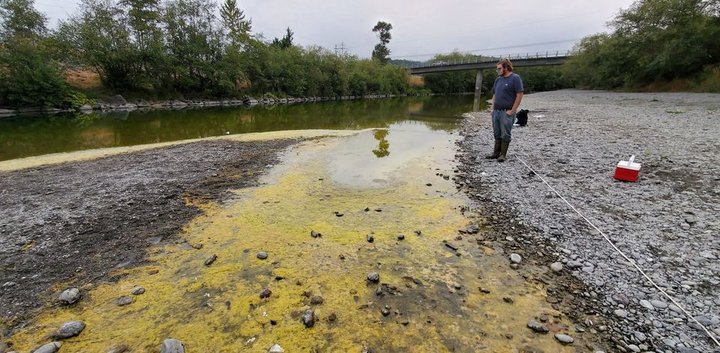
Photo: Jacob Pounds, Blue Lake Rancheria.
Word comes today, via the Blue Lake Rancheria’s Facebook account, that lab samples have confirmed the presence of anatoxin-a in the waters in the lower stretches of the Mad River, including at popular swimming and fishing spots near Blue Lake:
Water quality sampling done along the Mad River show a presence of toxins in the water that are hazardous and potentially life-threatening to pets and small children. The Blue Lake Rancheria Tribe‘s Environmental Department noticed visual signs of algae blooms along the Mad River this summer, and collected a series of water quality samples in early September at the state’s request.
Sampling results returned by the California Water Board show a presence of anatoxins from Blue Lake Bridge to Pump Station Four Park in Arcata. At this point, the tribe’s water quality experts advise the public to be extremely cautious, avoid contact with the river altogether, and absolutely avoid any noticeable algae mats along the Mad River.
The toxin comes from blooms of cyanobacteria — what old-timers used to call “blue-green algae” — and it has a long record of killing dogs and sickening people, especially children, in the fall months.
Jacob Pounds, environmental program coordinator with the Blue Lake Rancheria, told the Outpost this afternoon that the bacteria — well established in other local waterways, such as the Eel and the Klamath — has never been confirmed in the Mad before, though its presence has been suspected. (In 2016, Pounds said, a dog fell ill after swimming in the Mad, leading many to suspect cyanobacteria toxins in the water.)
The rancheria’s environmental services division is putting out the call for people and pets to avoid contact with the water — and especially any algae mats, as pictured above — along the lower stretch of the Mad at least until the first serious rains come.
“All contact with the water should be avoided until we get a nice big flush that moves the algae out to the ocean,” Pounds said. “Avoiding contact is going to be the best policy.”
###
DISCLOSURE: The Blue Lake Rancheria is a minority owner of Outpost parent company Lost Coast Communications, Inc.
###
UPDATE: Press release from the Humboldt County Department of Health and Human Services:
Samples with confirmed cyanobacteria were collected at three locations on the Mad River spurring local Public and Environmental Health Officials to warn community residents to keep themselves and their pets out of the water.
The samples containing the cyanobacteria, also known as blue-green algae, were collected by an Environmental Scientist for the Blue Lake Rancheria at a DHHS News Release - Cyanobacteria in the Mad River Recreational location known as Sewer Ponds, at Pump Station 4 and downstream of the Hatchery Road bridge.
Most cyanobacteria do not affect animals or people, however, a small number of cyanobacteria species are capable of producing toxins that can be harmful to animals and humans. Dogs and children are most likely to be affected because of their smaller body size and tendency to stay in the water for longer periods of time.
Cyanobacteria can be present in any fresh water body. It looks like dark green, blue-green, black, orange or brown scum, foam or mats on the riverbed or floating on the water. Warm water and abundant nutrients can cause cyanobacteria to grow more rapidly than usual causing “blooms.” These blooms are termed “harmful algal blooms.”
Officials recommend the following guidelines for recreational users of freshwater areas:
Keep children, pets and livestock from swimming in or drinking water containing algal scums or mats.
Adults should also avoid wading and swimming in water containing algal blooms. Try not to swallow or inhale water spray in an algal bloom area.
If no algal scums or mats are visible, you should still carefully watch young children and warn them not to swallow any water.
Fish should be consumed only after removing the guts and liver and rinsing fillets in tap water.
Never drink, cook with or wash dishes with water from rivers, streams or lakes.
Get medical attention immediately if you think that you, your pet, or livestock might have been poisoned by cyanobacteria toxins. Be sure to tell the doctor or veterinarian about possible contact with cyanobacteria or algal blooms.
Join or support one of the many watershed and river organizations.
In previous years, cyanobacteria was confirmed in some water bodies within Humboldt and surrounding counties, including the Mad River, South Fork Eel River, Van Duzen River, Trinity River, Clear Lake and Lake Pillsbury. It is difficult to test and monitor the many lakes and miles of our local rivers. Most blooms in California contain harmless green algae, but it is important to stay safe and avoid contact.
To learn more about cyanobacteria and harmful algal blooms, visit the state of California’s website at www.mywaterquality.ca.gov/habs/index.html.
To learn more about cyanobacteria and algae on the South Fork Eel River, visit www.eelriverrecovery.org/algae.html.
To report a bloom, e-mail CyanoHAB.Reports@waterboards.ca.gov or call 844-729-6466 (toll free). Blooms can also be reported via the “bloomWatch” app which is available for free download on iTunes or Google Play.
For information on conditions occurring within Humboldt County, contact the Division of Environmental Health at 707-445-6215 or 800-963-9241. Photos of suspected blooms can also be emailed to envhealth@co.humboldt.ca.us.
CLICK TO MANAGE